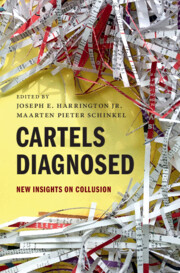Book contents
- Cartels Diagnosed
- Cartels Diagnosed
- Copyright page
- Contents
- Figures
- Tables
- Contributors
- Introduction
- 1 Entry Barriers, Personal Relationships, and Cartel Formation
- 2 “Now You Are Asking for a Real War!”
- 3 Coordinating Fuel Surcharges
- 4 Price Fixing or Fixing Competition?
- 5 The Role of Platforms for Facilitating Anticompetitive Communication
- 6 Collusion with Non-express Communication
- 7 Cartel Instability and Price Wars
- 8 Coordinated Rebate Reductions and Semi-collusion
- 9 Average Bid Auction Format Facilitates Bidding Rings
- 10 The Challenges of Cartelization with Many Products and Ongoing Technological Advancements
- 11 Two Cartels in the Supply Chain
- 12 Is it Collusion or Competition behind Price Parallelism?
- References
9 - Average Bid Auction Format Facilitates Bidding Rings
Construction Tenders in Italy
Published online by Cambridge University Press: 06 December 2024
- Cartels Diagnosed
- Cartels Diagnosed
- Copyright page
- Contents
- Figures
- Tables
- Contributors
- Introduction
- 1 Entry Barriers, Personal Relationships, and Cartel Formation
- 2 “Now You Are Asking for a Real War!”
- 3 Coordinating Fuel Surcharges
- 4 Price Fixing or Fixing Competition?
- 5 The Role of Platforms for Facilitating Anticompetitive Communication
- 6 Collusion with Non-express Communication
- 7 Cartel Instability and Price Wars
- 8 Coordinated Rebate Reductions and Semi-collusion
- 9 Average Bid Auction Format Facilitates Bidding Rings
- 10 The Challenges of Cartelization with Many Products and Ongoing Technological Advancements
- 11 Two Cartels in the Supply Chain
- 12 Is it Collusion or Competition behind Price Parallelism?
- References
Summary
◦ This case study illustrates how a particular auction design, used for public procurement, can unintentionally provide fertile ground for bidding rings.
◦ Essentially, the average bid auction format awards the contract to the bidder whose bid is nearest to the average bid. The average bid auction format has been advocated in order to prevent contracts being awarded to bidders with unrealistically low bids that might result in low quality or ex post renegotiation.
◦ This case study shows how it facilitates collusion. The setting is the tendering of public work projects in Turin, Italy over 2000–2003 where subgroups of construction firms formed cartels and coordinated their bids to enhance their chance of winning the contract at an inflated price.
◦ To understand the ease with which bidders can collude when participating in an average bid auction, suppose the current expectation (in the absence of coordination) is that firms bid aggressively. In order to have a chance to win, a firm would have to submit a relatively low bid in order for it to be close to the average bid. Now consider firms forming a cartel. All they need to do is agree to submit high prices. That will reap higher profits and without the temptation to deviate as is present with the usual auction design where the contract is awarded to the lowest bidder. A firm that thinks about submitting a lower bid will move its bid farther away from the average bid and thus reduce its chances of winning. Once firms agree to submit high bids, such an agreement is self-enforcing. The average bid auction format thus makes collusion more likely because cartel stability is so easy to maintain.
◦ The case study also explores an incentive for a subset of firms to form its own coalition in order to increase their chances of winning. If it comprises enough firms, they can move the average bid up or down in a manner to cause their bids to be closer to the average bid than the bids of firms outside of their coalition. As a result, a collection of bidders can respond to a coalition by forming its own coalition. The proliferation of these coalitions is well documented for the Turin case.
◦ This understanding of cartel conduct is used to develop a marker for collusion based on the frequency of joint participation.
- Type
- Chapter
- Information
- Cartels DiagnosedNew Insights on Collusion, pp. 249 - 271Publisher: Cambridge University PressPrint publication year: 2025

